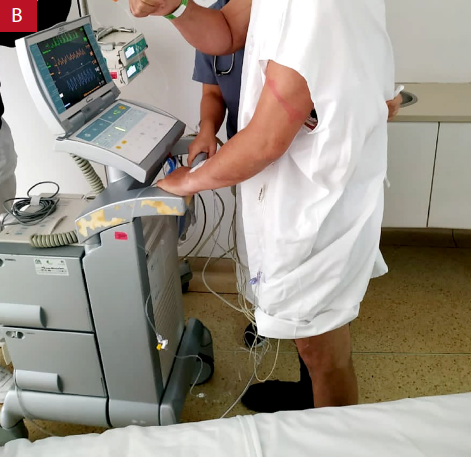Intra-aortic balloon contrapulsation through subclavian access as a bridge to heart transplantation. Case report
DOI:
https://doi.org/10.47487/apcyccv.v2i2.134Keywords:
Intra-Aortic balloon pumping, Heart failure, Heart transplantationAbstract
Advanced heart failure is a major health problem for which heart transplantation or left ventricular assist devices are the only effective treatments. Intra-aortic balloon pump inserted using femoral artery access as a bridge to heart transplantation is still frequently used, but has the disadvantage of limiting the patient’s movements, hence exposing him or her to the hazards of immobility and threatening the success of the procedure or hindering recovery. Access through the subclavian artery has become an attractive alternative since it doesn’t impair the patient’s mobility, and there is increasing evidence supporting its use. We present the first case of subclavian counterpulsation balloon implantation in a cardiovascular care center in Colombia.
Downloads
References
Crespo-Leiro MG, Metra M, Lund LH, et al. Advanced heart failure: a position statement of the Heart Failure Association of the European Society of Cardiology. Eur J Heart Fail. 2018 Nov;20(11):1505–35. doi: 10.1002/ejhf.1236.
Yancy CW, Jessup M, Bozkurt B, et al. 2013 ACCF/AHA guideline for the management of heart failure: executive summary: a report of the American College of Cardiology Foundation/American Heart Association Task Force on practice guidelines. Circulation. 2013 Oct 15;128(16):1810–52. doi: 10.1161/CIR.0b013e31829e8807.
Tanaka A, Tuladhar SM, Onsager D, et al. The Subclavian Intraaortic Balloon Pump: A Compelling Bridge Device for Advanced Heart Failure. Ann Thorac Surg. 2015 Dec;100(6):2151–7; discussion 2157-2158. doi: 10.1016/j.athoracsur.2015.05.087.
Norkiene I, Ringaitiene D, Rucinskas K, et al. Intra-aortic balloon counterpulsation in decompensated cardiomyopathy patients: bridge to transplantation or assist device. Interact Cardiovasc Thorac Surg. 2007 Feb;6(1):66–70. doi: 10.1510/icvts.2006.140160
Dick P, Mlekusch W, Delle-Karth G, et al. Decreasing incidence of critical limb ischemia after intra-aortic balloon pump counterpulsation. Angiology. 2009 May;60(2):235–41. doi: 10.1177/0003319708319782
Mayer JH. Subclavian artery approach for insertion of intra-aortic balloon. J Thorac Cardiovasc Surg. 1978 Jul;76(1):61–3.
Russo MJ, Jeevanandam V, Stepney J, et al. Intra-aortic balloon pump inserted through the subclavian artery: A minimally invasive approach to mechanical support in the ambulatory end-stage heart failure patient. J Thorac Cardiovasc Surg. 2012 Oct;144(4):951–5. doi: 10.1016/j.jtcvs.2012.03.007
Kantrowitz A, Tjonneland S, Freed PS, et al. Initial clinical experience with intraaortic balloon pumping in cardiogenic shock. JAMA. 1968 Jan 8;203(2):113–8.
Maccioli GA, Lucas WJ, Norfleet EA. The intra-aortic balloon pump: a review. J Cardiothorac Anesth. 1988 Jun;2(3):365–73. DOI: 10.1016/0888-6296(88)90320-1
Murks C, Juricek C. Balloon Pumps Inserted via the Subclavian Artery: Bridging the Way to Heart Transplant. AACN Adv Crit Care. 2016 Jul;27(3):301–15. doi: 10.4037/aacnacc2016355.
Cochran RP, Starkey TD, Panos AL, et al. Ambulatory intraaortic balloon pump use as bridge to heart transplant. Ann Thorac Surg. 2002 Sep;74(3):746–51; discussion 751-752. doi: 10.1016/s0003-4975(02)03808-0.
Bhimaraj A, Agrawal T, Duran A, et al. Percutaneous Left Axillary Artery Placement of Intra-Aortic Balloon Pump in Advanced Heart Failure Patients. JACC Heart Fail. 2020 Apr;8(4):313–23. doi: 10.1016/j.jchf.2020.01.011















